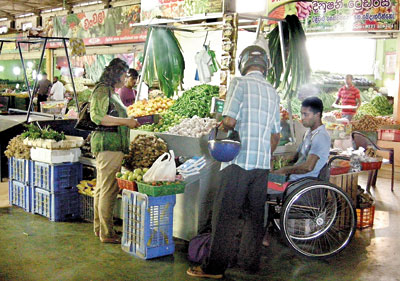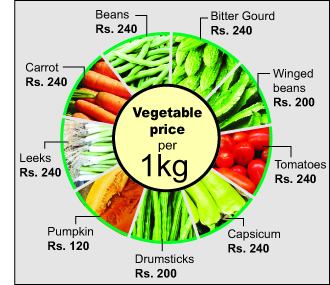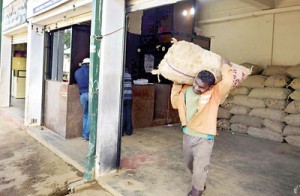News
Buyers recoil from soaring veg prices
“Two hundred and forty rupees per kilo, 240 per kilo, 240 per kilo …” goes the mantra by retail vegetable vendors in cities and suburbs as worried shoppers search the market for cheaper vegetables with prices of most vegetables having sky-rocketed.

Narahenpita Economic Centre: Sellers are seeing drastic reduction in customers. Pix by Athula Devapriya
The most popular vegetables have gone up in price, with beans being sold at Rs. 240 rupees per kilo, carrots, leeks, bitter gourd, and capsicum also at Rs. 240 per kilo while drumsticks, winged beans remain at Rs. 200 per kilo.
“The cheapest vegetables are plantain flowers and kekiri (cooking melon). Our children do not eat them. Usually I buy about seven or eight vegetables but today I bought only beans, carrot and snakegourd,” said A. Madawa, 49, from Rajagiriya, who was shopping to feed a family of five.
D. Shanthini, 56, from Nugegoda, is a vegetarian. For her, the sudden increase in prices comes as a shock.
“The vegetables that are sold at a reduced price are of real bad quality. The good ones are extremely expensive. I hope prices will not increase beyond this,” she said. “There should be a proper plan with cultivation to avoid such shortages and price hikes.”
S. Kumara, a vendor at the Narahenpita Economic Centre, said sellers are seeing drastic reduction in customers, especially with the price increase.

S. Kumara: A vendor

A. Madawa: Shopping to feed family of five
“We have to ensure that quality vegetables are available but most of the vegetables were affected by rain and easily rot. The rains have resulted in a shortage of both up-country and low-country vegetables. With much difficulty we found good quality carrots and leeks as well as pathola (snakegourd) and vetakolu (ridged gourd), he said.
According to the Hector Kobbekaduwa Agrarian Research and Training Institute (HARTI), the vegetable shortage and price increase will continue until late January when the first harvest from the Maha harvesting season comes in.
A research officer attached to HARTI said upcountry and low-country vegetables had reached the end phase of the Yala harvesting season and early land preparations for the upcoming Maha season had led to this shortage.
The peak seasons were from mid-January to mid-March (Maha) and then again in August (Yala).
“Usually in between the two peak seasons there is an intermediate season for vegetable cultivators. But this time, hit by the prolonged drought, they experienced a failed intermediate season and a weak Yala season,” said the HARTI analyst.
“As the heavy rains began last week desperate farmers hurriedly uprooted whatever was remaining in Yala and started preparing the land for the Maha season in fear of a future drought. They do not want to lose the Maha season,” she said.
She said there was a production plan but vegetable cultivation was more of an individual decision and the Agriculture Department could only advise, instruct and provide technical support.
Retail prices of most vegetables have increased since this time last year, with the highest rise, 113 per cent, recorded for beans.
The Census and Statistics Department states that compared to last year, the price of leeks has increased by 44.4 per cent, long beans by 42 per cent, carrots by 41.2 per cent, beetroot by 25.9 per cent, brinjal by 34 per cent and snakegourd by 25 per cent.
Damage to crops by heavy rain resulted in price increases to Nuwara Eliya vegetables. Farmers say that it will take another two months to cultivate and harvest new crops.
The Meteorology Department said inter-monsoonal rains this week will be experienced islandwide and localised heavy showers can cause floods
Heavy afternoon and evening thundershowers will continue, said Anusha Warnasuriya, the department’s Director of Forecasts.
| Nuwara Eliya: Veggies hit by bad weather
Wholesale prices of vegetables in Nuwara Eliya are soaring due to crops being ruined by bad weather. At the Nuwara Eliya Economic Centre, the wholesale price of carrots was Rs. 155-160 a kilo, Rs.150 per kilo for leeks, Rs. 55-60 for cabbage, Rs. 90 for beetroot and Rs. 55-60 for radish. Traders are experiencing difficulty in purchasing vegetables both wholesale and retail due to high demand and increased charges. Farmers say it will take another two months to cultivate and harvest new crops. –Shelton Hettiarachchi
|



